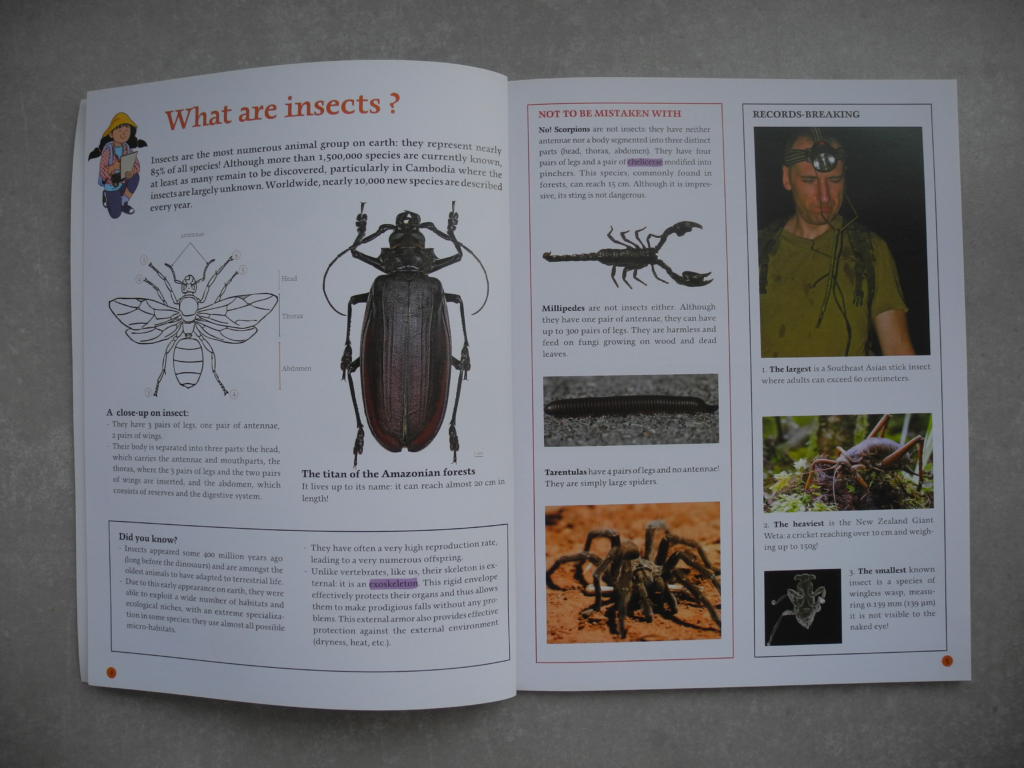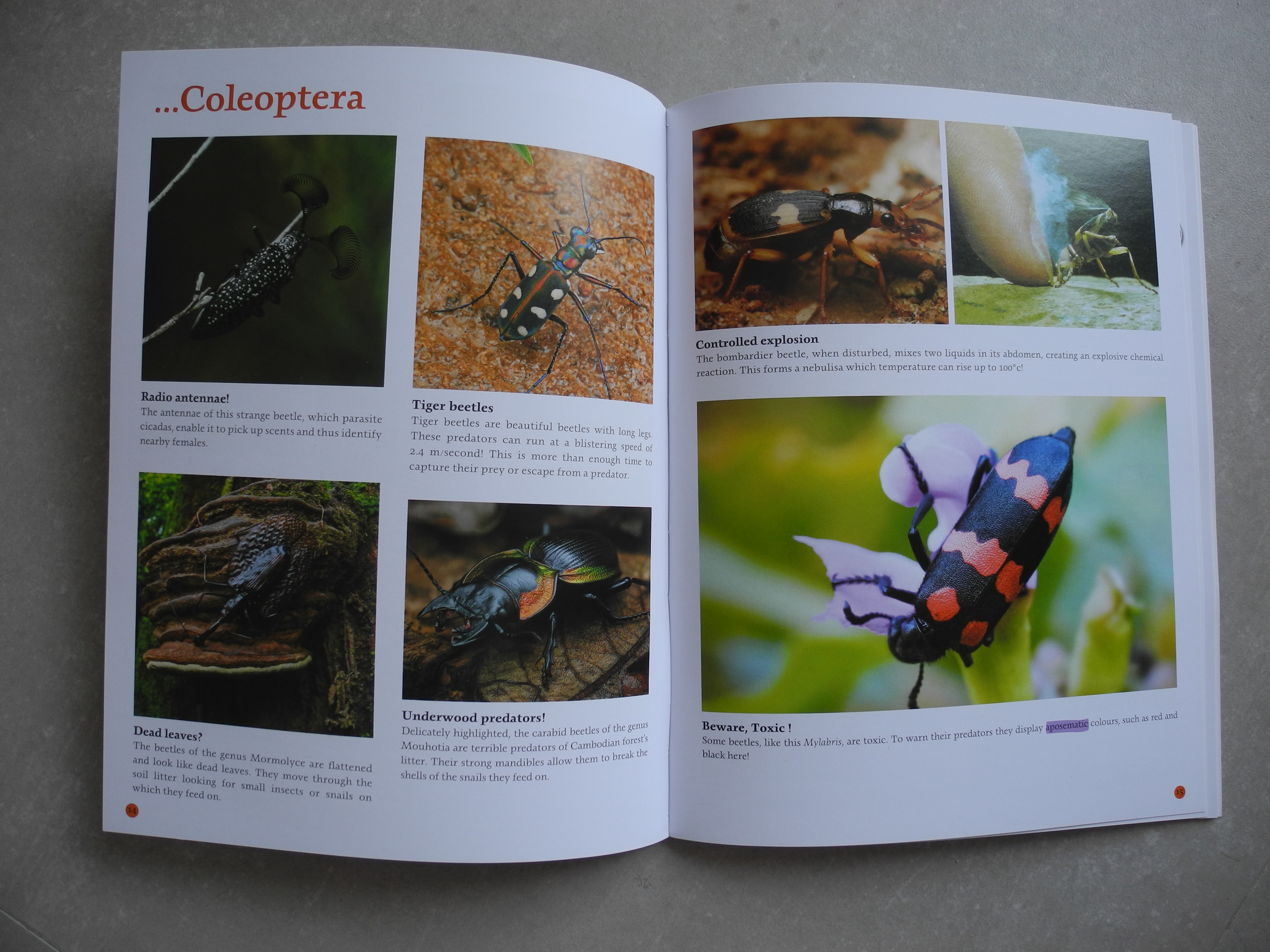
PHNOM PENH — The book “Insects in Cambodia” showcases insects in bright colors, providing basic information on what they are and the role they play in nature. Meant for readers young and old, it was produced through collaboration between Sipar, the book-publishing and library-service NGO, and the research and public health center Institut Pasteur du Cambodge.
Authored by two experts in entomology, the book describes the roles insects play in the environment and in the lives of animals and humans. With colorful photos and illustrations along with short explanations on every page, the 42-page book presents the various classifications of insects such as coleoptera (beetles), hymenoptera (ants and bees), lepidoptera (butterflies), and diptera (flies).
Since its release, the book has been a success among all Cambodian publics, said Hok Sothik, director of Sipar and also president of the Cambodian Librarians Association. This is the first publication on insects that makes it easy for children, young people and adults to understand and learn about insects, he said.
The book has been published in three languages: Khmer, English, and French. As Sothik explained, while written for the general public of all ages, the text also includes scientific terminology about insects, which may drive some readers to do research to learn more. There are not many books on insects in Khmer language, Sothik said.
According to the book “Insects in Cambodia,” there are more than 400,000 species of coleoptera. But there could be many more. Photo: mv
According to Sébastien Boyer, one of the book authors and the head of the Medical and Veterinary Entomology Unit at the Institut Pasteur du Cambodge, the institute and Sipar published the book in three languages so that the information is, he said, “accessible to as many young minds as possible, transcending language barriers and inviting children from different backgrounds to explore the fascinating world of Cambodian insects.”
Producing a book that would be both accessible to all readers and contain scientific information was no small project. During the process, the authors and the publisher went through many phases during which their opinions and views would differ, Sothik said, “The authors focused more on scientific aspects…while at Sipar, we prefer simple words accessible to a wider public,” he said. But in the end, they produced a text with with some scientific information as well as accessible to the general public.
For Boyer, this book is, he said, “testament to the importance of the volunteerism of skilled persons in order to write children’s books to stimulate their curiosity.”
The book “Insects in Cambodia” also highlights the dangers that some insects represent, dangers that animals and humans may face, Boyer said. “We think it is important to know global threats such as climate change, pollution, over-exploitation, destruction of habitats,” he said. “And we also suggest at the end [of the book] some positive actions.”

And in the last pages of the book, there is a quiz for people of all ages to check what they have learned in the book, making this a game for all, Boyer said.
While only his name appears as author of the book, Boyer said that all members of the research and public health center at the Institut Pasteur in Cambodia helped put together the information for this book so that it would be both educational and appeal to readers, and especially young ones.
Moreover, Pierre-Olivier Maquart, who has published seven books on entomology in France, contributed significantly so that the book would be, Boyer said, “a comprehensive and engaging resource” for young readers. Maquart, whose name appears on the book cover as one of the authors, is at the Institut Pasteur in Cambodia and also part of the Institut Pasteur International Network.
Sipar and the Institut Pasteur first worked together in 2016 to produce a book on rabies, which was published and distributed by Sipar as part of the “Sipar Book Collection: I would like to know,” Sothik said.

According to him, this recent collaboration should open the door for more such opportunities between the Institut Pasteur and Sipar. If only in entomology, there is room for more books on this topic in Cambodia, he said.
The Institut Pasteur has also contributed financially for the publication of this book in addition to providing the technical and scientific information, Sothik said.
So far, the “Insects in Cambodia” book has received positive feedbacks from the readers, and was named one of the best-sellers during the 10th Cambodia Book Fair held in Phnom Penh in December 2023 with more than 1,400 copies sold, including more than 800 copies in Khmer, Sothik said.
Since 1992, the Sipar NGO has been publishing books and making reading material accessible to children and adults through mobile libraries (on vans, tuk-tuks, boat and motorcycle), school libraries, reading corners in hospitals, garment factories and prisons.

